Mediterranean Garden Design: A Complete Guide
The enchanting allure of the Mediterranean landscape is undeniable. With its sun-kissed terraces, fragrant herbs, and the distant hum of cicadas, these gardens evoke a sense of serenity and timeless beauty. Focusing on French garden design ideas, this article unfolds the secrets behind creating an authentic Mediterranean haven right in your backyard. By imbibing sustainable practices and understanding the climatic adaptation required, even those in non-Mediterranean climates can achieve this design. From the rich history of Mediterranean gardens to their modern design challenges, let’s embark on this verdant journey.
As we traverse this landscape, you will gain insights into the essential plants that make up this garden, the importance of stones and pathways, and how elements like pergolas, terracotta pots, and water features enhance the authenticity. Moreover, you’ll understand the significance of adapting to seasonal blooms and how incorporating wildlife-friendly designs can create an ecological balance.
Whether you have acres of land or just a small patio, there’s a Mediterranean design waiting for you. Here’s how you can bring it to life.
Mediterranean Garden Design Ideas for Small Spaces
Introduction
Small spaces need not be deterrents to achieving the Mediterranean garden of your dreams. The beauty of the Mediterranean design lies in its adaptability. With a few smart design choices and strategic plant placements, any small space can exude the charm and warmth of a Mediterranean garden.
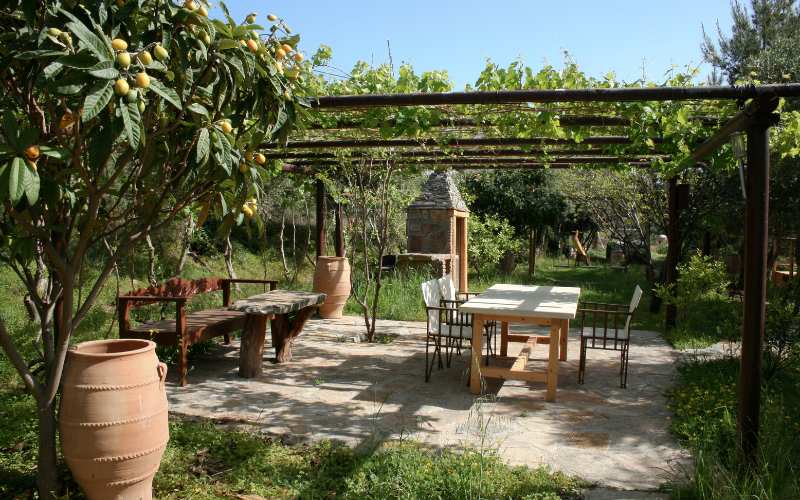
Terracotta Magic
The rustic appeal of terracotta pots can be used to imbue even the smallest of spaces with that authentic Mediterranean feel. Stacked, grouped, or singularly placed, these pots can house a range of plants from citrus saplings to fragrant herbs. Opt for pots in varied sizes and designs, but ensure a weathered look for that true Mediterranean charm.
Vertical Solutions
For spaces that lack horizontal sprawl, think vertically. Installing vertical planters or green walls adorned with ferns, herbs, and climbers such as the delicate Jasmine can create a lush vista. Hanging pots with trailing plants like ivy or Spanish moss can also make for a gorgeous aerial view.
Seating and Shade
Incorporate compact seating areas, perhaps a wrought-iron bench or mosaic-tiled stool, under a small pergola or canopy. Draped with climbing plants or light, airy fabrics, it provides a shaded spot that embodies the Mediterranean leisurely spirit.
Water Feature Wonders
Even a small fountain or a tabletop water feature can introduce the calming sound of flowing water, evoking the peaceful ambiance of Mediterranean courtyards.
Essential Plants
Introduction
Central to any Mediterranean garden, big or small, are its signature plants. Their choice and placement play a pivotal role in recreating the region’s unique landscape.
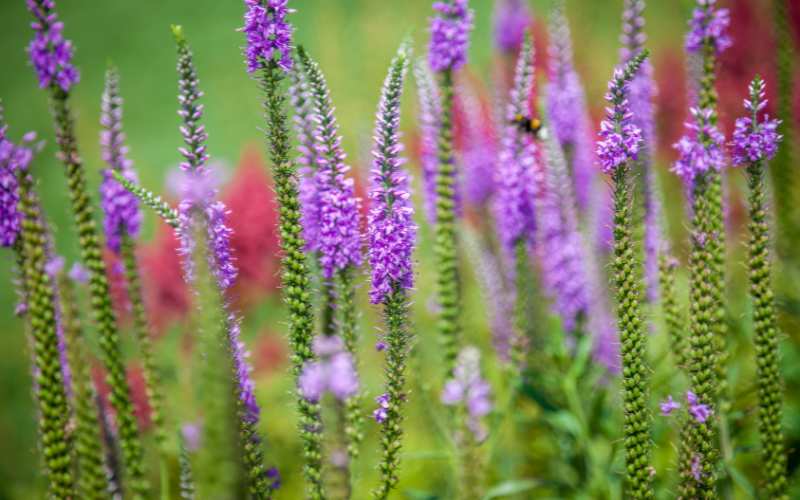
Olive Trees
Olive trees, even in their dwarf varieties, bring in a robust Mediterranean character to any garden. While their gnarled trunks tell tales of the ancient world, their silvery leaves shimmer under the sun, creating dynamic visual interest.
Lavender Fields Forever
No Mediterranean garden is complete without lavender. It’s not just about their vibrant purple hue, but also the calming fragrance that they infuse into the surroundings. Lavender plants are also great for borders or as fillers between larger plants.
Rosemary: A Culinary and Visual Treat
Rosemary is an evergreen shrub with needle-like leaves and blue flowers. A staple of the Mediterranean landscape, its aromatic presence is both a culinary delight and a visual treat, especially when planted alongside pathways or in terracotta pots.
Citrus Trees in Pots
Citrus trees, especially lemons and oranges, resonate deeply with Mediterranean vibes. For smaller spaces, dwarf citrus trees in ornate pots can be strategically placed to provide both aesthetics and fresh produce.
Creating a Mediterranean Oasis at Home
Introduction
A Mediterranean oasis at home is more than just plants and pathways. It’s about creating a holistic environment that reflects the serene and leisurely pace of Mediterranean life.
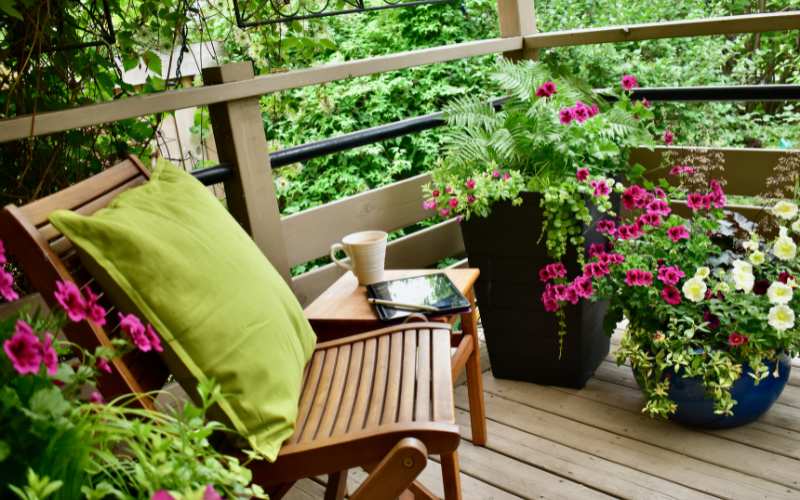
Balance of Elements
Ensure a balance between hardscape and softscape. While plants provide softness and color, hardscaping elements like benches, statues, and pathways offer structure. Incorporating both ensures a garden that’s both functional and beautiful.
Scented Corners
Dedicate corners of your garden to fragrant herbs and flowers. From basil to thyme and roses to jasmine, these pockets can become places of solace, where one can retreat with a book or a cup of tea.
Incorporating Cultural Elements
Whether it’s a Spanish-inspired mosaic tabletop or a Grecian statue, introducing cultural elements can add authenticity to your oasis. They not only serve as focal points but also as conversation starters.
Shade and Leisure
Central to the Mediterranean lifestyle is leisure. Create shaded nooks using pergolas or even large trees, where one can recline during the hottest parts of the day. Add comfortable seating, perhaps a hammock or lounge chairs, to amplify the relaxation factor.
Using Stones

Introduction
Stones, in their various forms, are integral to Mediterranean landscapes. They bring in texture, earthiness, and a touch of rustic charm, essential to the region’s aesthetic.
Gravel Pathways
Gravel paths, interspersed with occasional stepping stones or bordered by low-growing plants, can meander through the garden, guiding visitors and creating visual interest. The soft crunch underfoot also adds an auditory element to the garden experience.
Stone Walls and Borders
Dry stone walls, a traditional Mediterranean feature, can serve as borders, retaining walls, or even as backdrops for plant beds. Their rugged appearance complements the soft foliage, creating a harmonious juxtaposition.
Pebble Mosaics
Infuse art into your garden with pebble mosaics. Whether it’s a pathway, a patio floor, or just a decorative corner, these mosaics, inspired by ancient Roman and Greek designs, can be both beautiful and functional.
Stone Planters
Swap traditional pots with stone planters. Their earthy appearance harmonizes well with Mediterranean plants, and they’re durable, making them perfect for both succulents and larger shrubs.
Olive Trees and Their Role
Introduction to Olive Trees
Olive trees, with their gnarled trunks and silvery leaves, are a quintessential symbol of the Mediterranean landscape. More than just a plant, they are a testament to the region’s history and culture, embodying the very essence of the Mediterranean spirit.
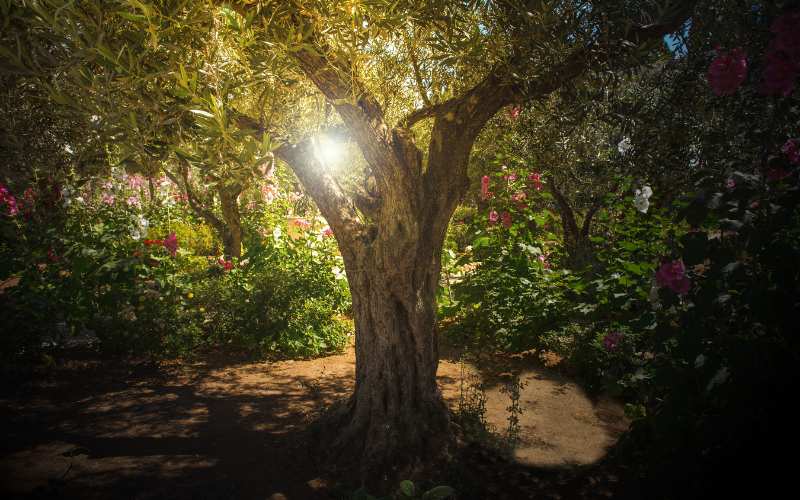
Historical Significance
Historically, olive trees have held immense significance in the Mediterranean region. They’ve been cultivated for over 6,000 years, not just for their olives but also for the precious oil that has played roles in culinary, cosmetic, and religious traditions. Ancient civilizations, from the Greeks to the Romans, have revered the olive tree, often associating it with peace, wisdom, and prosperity.
Agricultural Role
In terms of agriculture, olive groves are a primary source of income for many Mediterranean countries. The cultivation methods, often passed down through generations, have become a blend of tradition and innovation, ensuring sustainable practices while meeting the demands of the modern world.
Aesthetic Appeal in Gardens
In Mediterranean garden design, olive trees serve both a functional and aesthetic purpose. Their twisted trunks, a result of centuries of pruning and growth, become natural sculptures in a garden setting, while their canopy offers shade and their leaves create a unique silvery backdrop against the blue Mediterranean sky.
Symbolism in Design
Symbolically, including an olive tree in one’s garden is akin to embedding a piece of Mediterranean history. It stands as a reminder of the region’s rich past, its agricultural prowess, and its undying connection to nature.
Water Features
The Essence of Water in Mediterranean Design
Water features play a pivotal role in Mediterranean gardens, symbolizing life, abundance, and tranquility. The gentle sound of trickling water evokes a sense of peace, reminiscent of ancient courtyards and lush oases.

Fountains: The Heartbeat of a Garden
Traditionally, fountains have been central to many Mediterranean gardens. Whether grand with intricate mosaics or simple stone basins, they serve as gathering spots, offering respite from the heat. Birds are often drawn to them, adding a touch of wildlife and a melodic backdrop to the garden ambiance.
Ponds and Reflecting Pools
Ponds and reflecting pools, often lined with tiles or surrounded by stone pathways, introduce a serene element. They mirror the sky, create a habitat for aquatic plants and animals, and offer a contemplative space for visitors.
Cascades and Waterfalls
For gardens with a natural slope or gradient, cascades or small waterfalls can be incorporated. The sound of flowing water down a series of rocks or steps adds dynamism and a touch of wilderness to the structured garden space.
Maintenance and Sustainability
While water features are undoubtedly beautiful, they require regular maintenance to prevent algae growth and ensure clean water circulation. Embracing sustainable practices, like using solar-powered pumps or collecting rainwater, aligns with the Mediterranean ethos of living in harmony with nature.
Pots and Planters

The Versatility of Terracotta
Terracotta pots, with their earthy hue and porous nature, are synonymous with Mediterranean gardens. Their breathability makes them perfect for plants that dislike waterlogged roots, and their rustic appearance complements the natural beauty of various flora.
Variety and Placement
From bulbous urns to slender amphorae, the variety of pots and planters available can cater to every gardener’s aesthetic and functional needs. Grouping them, staggering them in heights, or creating a cascade effect on terraces can introduce depth and dimension to garden design.
Creative Pottery
Mosaics, paintings, or simple glazed pots can add color and artistry to the garden space. Many Mediterranean countries, like Spain and Italy, have pottery traditions that produce exquisite designs, each telling a story of its cultural heritage.
Repurposing and Recycling
Old wine barrels, ceramic bowls, or even worn-out boots can be repurposed into planters. They not only serve a functional purpose but also introduce a whimsical, eco-friendly element to garden design.
Drainage and Care
Regardless of the choice of planter, ensuring proper drainage is crucial. Overwatering or stagnant water can harm plant roots. Regular cleaning and, in the case of terracotta, occasional sealing can ensure the longevity of the pots and the health of the plants they house.
Pathway Inspirations
The Allure of Gravel Paths
Gravel paths, with their soft crunch underfoot, are a classic choice for Mediterranean gardens. They’re permeable, allowing rainwater to seep through, and their neutral color highlights the greenery and blooms alongside them.
Stone Stepping Stones
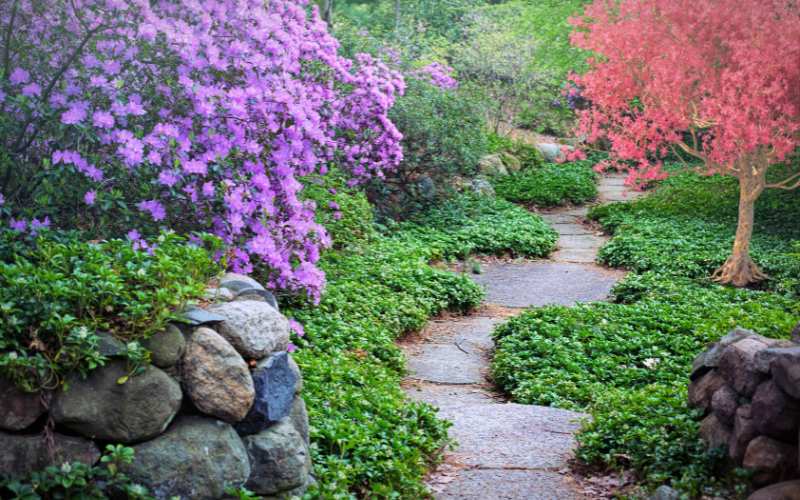
Incorporating stepping stones, be it slate, limestone, or sandstone, can break the monotony of long paths. They introduce texture and can be laid out in creative patterns, guiding visitors on a journey through the garden.
Mosaic Magic
Mosaics, an art form with deep roots in Mediterranean history, can turn simple paths into visual masterpieces. Whether it’s geometric patterns, floral motifs, or scenes from mythology, they transform the garden floor into a canvas.
Boardwalks and Wooden Paths
For gardens with damp areas or those aiming for a coastal Mediterranean vibe, wooden boardwalks or paths are an ideal choice. They elevate the walkway, protect plants, and give the garden a beachy, relaxed ambiance.
Bordering and Edging
Borders, whether made from bricks, stones, or low-growing plants like lavender or thyme, provide definition to pathways. They guide the eye, keep gravel or sand in place, and can even become fragrant additions to the garden journey.
Tips for a Sustainable Mediterranean Garden
Embrace Drought-Tolerant Plants
In the Mediterranean, summers can be harsh and water might be scarce. Embracing drought-tolerant plants like lavender, rosemary, and various succulents not only conserves water but ensures your garden remains vibrant even in the peak of summer.
Mulching and Soil Care
Mulch is a gardener’s ally in the Mediterranean climate. It preserves soil moisture, regulates soil temperature, and prevents weed growth. Using organic mulch like straw, leaves, or bark can enrich the soil as they decompose.
Harvest Rainwater
Given the sporadic nature of rain in the region, collecting and storing rainwater is a wise practice. Installing rain barrels or underground cisterns can provide a sustainable water source for the garden during drier months.
Adopt Organic Practices
Avoiding chemical fertilizers and pesticides and opting for organic and natural alternatives not only nurtures the soil but also protects the local ecosystem. Composting kitchen waste can provide nutrient-rich compost for the garden.
Eco-Friendly Garden Accessories
Whether it’s solar-powered garden lights, recycled terracotta pots, or upcycled garden furniture, every sustainable choice reduces the carbon footprint of the garden and supports the environment.
Encourage Beneficial Wildlife
Introducing bird baths, insect hotels, and wildlife-friendly plants ensures a healthy ecosystem within the garden. These features attract pollinators and natural predators, reducing the need for chemical interventions.
The Role of Terraces
Historical Context
Terracing, a practice that dates back millennia, is often associated with agriculture in the hilly regions of the Mediterranean. It maximizes the useable land, prevents soil erosion, and ensures better water retention.
Aesthetic and Functional
In garden design, terraces introduce multiple levels and dimensions. They can segregate spaces based on plant types, sun exposure, or functionality, and offer vantage points to view different sections of the garden.
Materials and Construction
Traditional Mediterranean terraces are made using local stones, ensuring a natural integration with the landscape. The choice of stone often reflects the regional geology, from limestone in parts of Italy to sandstone in Greece.
Planting on Terraces
Terraced sections are ideal for various plants. Top terraces can house sun-loving plants, while lower sections, which might be shaded by upper terraces, can accommodate plants that prefer indirect light.
Maintenance and Safety
Terraced gardens require careful maintenance. Ensuring structural integrity, preventing weed growth between stones, and regular checks for signs of erosion or landslides are crucial for the longevity and safety of terraced gardens.
Incorporating Patios

The Heart of the Garden
Patios often serve as the nucleus of Mediterranean gardens. They’re places of relaxation, dining, and socializing, offering a transitional space between the home and the garden.
Materials in Sync with Nature
Traditional patios might feature natural stone floors, often in hues that echo the surrounding landscape. Terracotta tiles, another popular choice, add warmth and character.
Furnishing the Patio
Mediterranean patios often include comfortable seating, shaded by pergolas or large umbrellas. Wooden or wrought iron furniture, adorned with colorful cushions, create an inviting ambiance.
Integrating Plant Life
Potted plants, climbing vines, or even a central citrus tree in a large planter can introduce greenery to the patio without overwhelming the space.
The Dance of Light and Shade
Incorporating elements like lattice screens, trellises, or even sheer drapes can play with the interplay of light and shade, creating mesmerizing patterns and ensuring respite from the midday sun.
Native Shrubs
The Backbone of Mediterranean Gardens
Shrubs like rosemary, sage, and thyme are not just culinary delights but form the structural backbone of many Mediterranean gardens. Their resilience, fragrance, and evergreen nature make them invaluable.
Benefits of Native Shrubs
Opting for native shrubs ensures a garden that’s adapted to the local climate and soil. These plants have evolved over millennia, requiring minimal intervention and maintenance.
Wildlife Magnets
Many native shrubs are a source of nectar for pollinators. Their flowers and seeds also provide sustenance to local birds and insects, fostering a vibrant ecosystem.
Designing with Shrubs
While shrubs can form hedges or borders, they can also be the focal points of garden sections. Some, like the tree heath, bloom profusely, while others, like the myrtle, are prized for their aromatic leaves.
Sustainable Gardening with Native Shrubs
Incorporating native shrubs supports biodiversity, conserves water, and reduces the need for fertilizers or pesticides, making them an eco-friendly choice for gardeners who prioritize sustainability.
Color Palette
Mediterranean gardens are synonymous with a rich yet soothing array of colors that evoke the feelings of summer days by the sea and serene evening sunsets.
Earthen Tones and Bright Blooms
The primary foundation of Mediterranean gardens is their reliance on earthen and muted tones. Terracotta pots, sandstone pathways, and rustic wooden elements set the base. Contrasting this are the bright purples of lavender, the yellows of sunflowers, and the fiery reds of poppies. The beauty is in the juxtaposition of the muted with the vivid.
Cool Blues and Whites
Evoking the imagery of the sea and the whitewashed houses of Santorini, incorporating blues and whites can bring a cooling effect to the garden. Plants such as the blue plumbago or white roses can provide this refreshing touch.
Muted Greens
Green is undoubtedly a significant color in any garden, but in the Mediterranean palette, it’s often the silvery greens of olive trees or the muted green of sage that dominate, adding a unique touch.
Incorporating Seasonal Changes
While a majority of Mediterranean plants are evergreen, seasonal blooms can introduce new colors at different times of the year. This ever-evolving tapestry ensures the garden remains dynamic and ever-refreshing.
Influence of Art
Many Mediterranean gardens also feature art sculptures or mosaic tiles, adding bursts of color and intricacy to the landscape. Incorporating regional artistic influences can further enhance the authenticity of the garden’s aesthetic.
The Importance of Shade
In a region known for its intense sunlight and hot summers, the incorporation of shade in Mediterranean gardens is not just for aesthetic appeal—it’s a necessity.
Natural Canopies
Trees like olive, cypress, and citrus don’t just bring their distinct looks and fragrances; they offer natural shade. Placing seating areas or patios beneath their canopy ensures comfortable spots even during the midday sun.
Pergolas and Arbors
Wooden or stone pergolas covered with climbing plants or drapes provide respite from the sun and create cozy, intimate spaces. They’re ideal for dining areas or reading nooks.
Climbing Plants for Shade
Grapevines, wisteria, or jasmine can be trained over structures, walls, or fences, offering a green curtain that filters sunlight and casts dappled shadows on the ground.
Importance for Plant Health
Shade also benefits plants that aren’t adapted to constant sunlight. By ensuring some sections of the garden remain shaded, one can cultivate a more diverse range of flora.
Reflecting Light
Interestingly, while shade is vital, reflecting light is also a technique used in Mediterranean gardens. White walls or light-colored stones can reflect light, brightening up shaded areas and creating a unique interplay of light and dark.
Climbing Plants
Climbing or trailing plants play a pivotal role in Mediterranean gardens, bringing vertical interest, shade, and a touch of wildness.
Wisteria’s Cascading Beauty
The drooping purple clusters of wisteria, especially when in full bloom, can transform pergolas and walls into living art pieces. Their fragrance is an added bonus.
Jasmine’s Nightly Perfume
Jasmine isn’t just known for its star-shaped white flowers. As evening approaches, the garden gets filled with its intoxicating scent, making night-time garden strolls a sensory delight.
Grapevines: Utility and Aesthetics
Historically, grapevines were cultivated for their fruit and wine. In gardens, they offer dense foliage, which can provide shade, and in the autumn, a fiery display of colors.
Bougainvillea’s Fiery Display
With its bright bracts in shades of pink, red, or orange, bougainvillea can be a showstopper. Whether on walls or trellises, it adds a tropical flair to the Mediterranean garden.
Maintenance and Training
While climbing plants bring beauty, they also require maintenance. Regular pruning, ensuring they don’t overrun other plants, and training them on supports are essential tasks for the gardener.
Fragrance
A walk in a Mediterranean garden is a journey of scents. The region’s plants are not just visually appealing; they engage the olfactory senses profoundly.
Lavender’s Calming Scent
Lavender, with its purple spires, is a hallmark of Mediterranean gardens. Beyond its looks, its calming scent has therapeutic properties and is a magnet for pollinators.
Rosemary and Culinary Delights
Rosemary is not just a culinary herb. Its needle-like leaves emit a strong fragrance, especially when brushed against, making it a favorite for pathways or borders.
Citrus Blossoms
Citrus trees, like lemon or orange, when in bloom, can fill the air with a sweet, tantalizing aroma. It’s a reminder of the Mediterranean’s rich agricultural heritage.
Evening Scents
Some plants, like the night-blooming jasmine, come alive post-sunset. Designing a garden that offers fragrant delights round the clock ensures a multi-layered sensory experience.
The Therapeutic Garden
There’s growing evidence that fragrances, especially from plants, have therapeutic properties. A garden filled with aromatic herbs and flowers can be a space of relaxation, healing, and meditation.
Designing for Wildlife
A sustainable garden thrives not only due to its plants but also the fauna it attracts. The Mediterranean garden can be a sanctuary for various wildlife if designed thoughtfully.
Birds and the Music They Bring
Trees like olive and cypress, or shrubs like rosemary, provide perfect nesting spots. Bird baths or small ponds can act as water sources, attracting feathered visitors whose songs fill the air.
Pollinators and Their Critical Role
Plants like lavender, sage, and other flowering species are pollinator magnets. Bees, butterflies, and even hummingbirds play a crucial role in ensuring the garden’s health and productivity.
Natural Pest Control
By designing for insects and small reptiles, a garden can maintain a biological balance. Lizards, for example, control pests, and certain plants repel unwanted insects.
Water Features and Their Dual Purpose
While water features add aesthetic value, they also provide habitats. Ponds can attract frogs and dragonflies, helping control mosquito populations.
Wildlife-friendly Practices
Avoiding pesticides, providing natural shelters, and choosing plants that produce berries or seeds are strategies to make a garden more inviting to wildlife.
Maintenance Tips
Maintaining a Mediterranean garden’s beauty requires understanding its natural rhythms and requirements.
Watering Wisely
Drought-tolerant doesn’t mean water-free. Plants, especially during their growth phase, need water. The trick is to water deeply but infrequently, mimicking the natural rainfall pattern.
Pruning Practices
Regular pruning, especially for shrubs and trees like olive or rosemary, ensures healthy growth. Removing dead or diseased branches is vital for the plant’s health.
Soil Health
Mediterranean gardens thrive in well-drained soils. Regularly adding compost can enhance soil fertility and structure.
Managing Pathways
Gravel paths or stone pathways need occasional raking and weeding. Ensuring they’re level and stable guarantees they remain functional and aesthetically pleasing.
Seasonal Care
While Mediterranean gardens are relatively low-maintenance, seasonal tasks like mulching in summer or protecting delicate plants in winter are crucial.
The History and Evolution of Mediterranean Gardens
Mediterranean gardens, rich in history, are a confluence of various cultures and their relationship with the land.
Ancient Beginnings
Historically, Mediterranean gardens served practical purposes. They were spaces for growing food, herbs, and medicinal plants, intricately linked to daily life.
Roman Influence
Romans introduced formal elements like symmetrical designs, terraces, and water features. Their villas had gardens that were both functional and recreational.
Moorish Legacy
In regions like Spain, the Moors left an indelible mark. Their gardens were places of solace, with reflecting pools, fountains, and fragrant plants, reflecting their vision of paradise.
Renaissance and Beyond
The Renaissance period in Italy brought about elaborate gardens, showcasing art, sculptures, and a renewed interest in nature.
Modern Adaptations
Today’s Mediterranean gardens, while rooted in history, address modern challenges. They’ve become symbols of sustainable practices, focusing on native plants and water conservation.
Using Sculptures and Art
Art elevates the garden from merely being a collection of plants to a space of reflection, history, and personal expression.
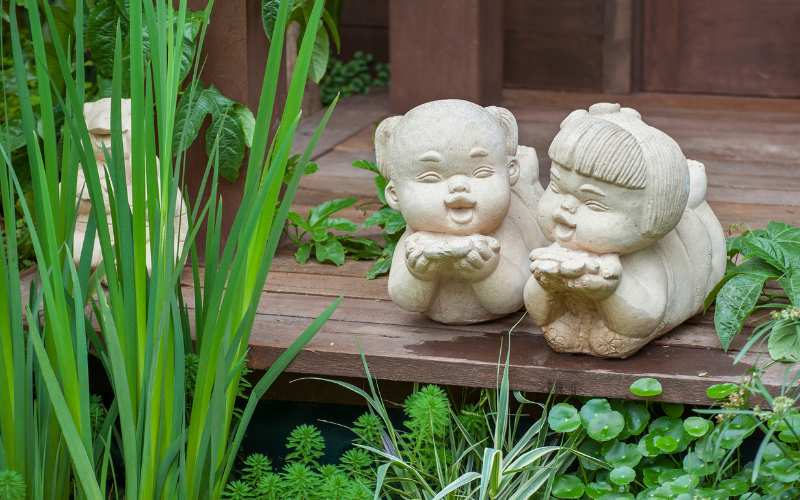
Statues and Their Timelessness
From classical Roman figures to modern abstract pieces, statues add a layer of depth. They can be focal points or subtly blend, narrating stories or evoking emotions.
Mosaics and Color Bursts
Mosaics, with their intricate designs and vivid colors, can brighten up walls, fountains, or pathways. They’re a nod to the rich artistic traditions of the Mediterranean.
Functional Art
Art isn’t just for viewing. Sculpted benches or artistically designed bird baths serve practical purposes while adding aesthetic value.
Personal Expressions
Art in the garden is also a reflection of the gardener. It’s an opportunity to express personal tastes, memories, or aspirations.
Integrating Art Thoughtfully
While art adds value, it’s essential to integrate it thoughtfully. Ensuring it complements the garden’s design, rather than overpowering it, is crucial.
Incorporating Pergolas and Arbors
Pergolas and arbors are more than mere decorative features in Mediterranean gardens; they’re functional, historical, and deeply embedded in the landscape’s fabric.
Historical Significance
Rooted in ancient history, these structures have served gardens for millennia. The Romans and Greeks incorporated them as places of rest, contemplation, and even ceremonial purposes.
Climbing Companions
Pergolas and arbors are known for supporting climbing plants. Vines like wisteria or grape, when draped over them, create a natural canopy offering shade and visual appeal.
Creating Microclimates
These structures can significantly modify local climate underneath them. They provide shade, reduce temperatures, and allow for plants that require less sun.
Architectural Beauty
Beyond function, they introduce vertical design elements, breaking the garden’s horizontal monotony. Their geometric patterns, when juxtaposed against the organic forms of plants, create a striking visual balance.
Material Matters
Traditionally made of wood, modern pergolas incorporate metals, vinyl, and even fiberglass. The choice depends on aesthetic preferences, durability requirements, and climatic adaptation.
Seasonal Blooms
Mediterranean gardens, often perceived as constant, undergo beautiful transformations throughout the year.
Spring Splendor
Spring in a Mediterranean garden is a riot of color. Early bloomers like lavender and rosemary create a fragrant carpet, heralding warmer days.
Summer Resilience
While many gardens struggle in the summer heat, Mediterranean gardens shine. Plants like oleander and bougainvillea flaunt their vibrant blossoms, and drought-tolerant species ensure constant greenery.
Autumn Hues
The fall brings a muted palette. Deciduous trees don golden hues, and late bloomers offer a final flourish before winter sets in.
Winter Textures
Though a quiet period, winter highlights the garden’s structural elements. The silhouettes of bare trees, the textures of evergreen shrubs, and the resilience of ground covers like thyme come to the fore.
Inspirations from Mediterranean Countries
Each country along the Mediterranean has contributed uniquely to garden design, offering a treasure trove of ideas.
Italy’s Renaissance Reflection
The Italian Renaissance gardens, with their symmetrical designs, water features, and terraced layouts, are masterclasses in structure and formality.
Grecian Naturalism
Greek gardens embrace nature’s wildness. Their emphasis on native shrubs, wildlife-friendly designs, and simple stone pathways echo the rugged Grecian landscapes.
Spanish Moorish Magic
The Moors left a legacy in Spain of gardens characterized by reflective pools, shaded courtyards, and fragrant plants, embodying a serene oasis.
French Garden Sophistication
French gardens blend formality with bursts of colors. Their parterres, ornate planters, and judicious use of sculptures are inspirations for elegance.
Challenges and Solutions
Mediterranean gardens, while resilient, face unique challenges in modern times.
Water Scarcity
As water becomes precious, these gardens, known for drought tolerance, become even more relevant. Employing sustainable practices like rainwater harvesting or using gray water can address this issue.
Space Crunch
Urban spaces are shrinking. Design challenges include fitting authentic elements into small spaces without overwhelming them. Vertical gardening, using planters, and multi-purpose structures can be solutions.
Climate Change
Shifting climatic patterns may affect plant choices. Being adaptive, selecting plants based on current climate trends, and regularly updating plant choices are ways forward.
Preserving Authenticity
In a world of homogenized gardens, retaining the authentic Mediterranean essence becomes a challenge. Embracing history, understanding cultural inspirations, and focusing on native plants are solutions.
Using Grasses and Ground Covers
Grasses and ground covers play a vital, often understated, role in Mediterranean gardens.
Diverse Palette
From blue fescue’s steel-blue hues to the green carpets of creeping thyme, the color range is diverse.
Erosion Control
On terraces or slopes, ground covers prevent soil erosion, maintaining the garden’s structural integrity.
Low Maintenance Champions
Grasses like Zoysia or Bermuda require minimal care, are drought-tolerant, and can handle foot traffic, making them ideal for busy homeowners.
Ecological Role
Ground covers suppress weeds, reduce water evaporation from the soil, and provide habitats for beneficial insects, playing a critical ecological role.
Artistic Expressions
Grasses, with their movement and textures, add an artistic touch. Their swaying forms in breezes or the sound they make can be therapeutic.
Conclusion
Mediterranean gardens, steeped in history and adapted to their unique climatic challenges, are more than just a testament to nature’s resilience; they are a celebration of life, color, and diversity. From the shade of pergolas draped in climbing vines to the soothing sounds of water features, these gardens encapsulate serenity and sustainability. The delicate balance of form and function, where every plant, from towering cypress trees to humble ground covers, plays a role, reveals the mastery of ancient garden designers.
Drawing inspiration from various Mediterranean countries offers a rich tapestry of design ideas. From the structured beauty of French gardens to the wild naturalism of Grecian landscapes, there’s a myriad of styles to explore. And while these gardens face modern challenges, from water scarcity to climate change, they also offer innovative solutions, reminding us of the importance of sustainable practices.
The beauty of the Mediterranean garden is its adaptability. Whether you have expansive grounds or a modest balcony, the principles remain the same: harmonize with nature, embrace sustainability, and celebrate every season’s unique offerings. As we move forward, these ancient gardens not only remind us of our past but also guide us towards a more sustainable, beautiful future.
